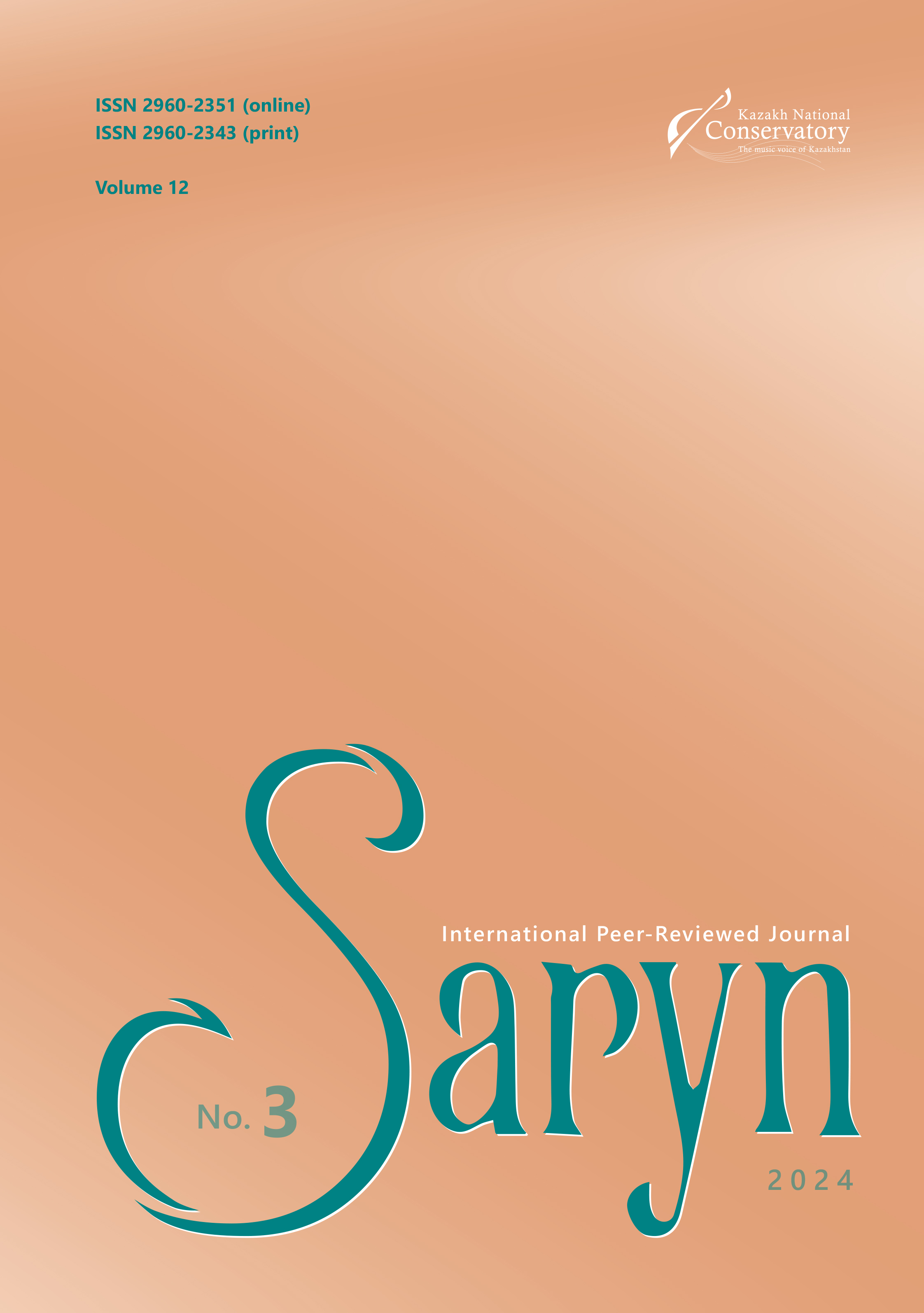Article information
Article publication date
2024-09-23
Article Page
74–94
Chapter
Arts & Humanities
License
Abstract
This article is about studying the saxophone works of Kazakh composers Arthur Orenburgsky, Alibi Abdinurov and Yulia Lebedeva, based on Kazakh folk music. These compositions have become an important part of the performing and pedagogical practice of saxophonists in Kazakhstan, and they are regularly performed at major concert venues, festivals and competitions. The purpose of the work is to study the process of creating compositions, their role in the formation of the national repertoire and the development of performing practice, as well as to identify the characteristic features in style and performance technique.
The authors use various methods in their research: complex approach, including analytical and historical that includes collection and exploration of archival material, as well as anthropological method like interviews with Kazakh composers and teachers of saxophone class of the Kurmangazy Kazakh National Conservatory.
The study revealed the main musical characteristics of saxophone compositions corresponding to Kazakh traditional music: metrical freedom, improvisation, uniqueness of rhythm, shaping and timbre. The studied works represent the authors’ reinterpretation of traditional primary sources, through imitation of rhythmic elements of dombra playing and sound production characteristic of folk wind instruments. These elements define the national color in music and can be considered as “ethnic identity”.
From a practical point of view, this work will be useful for musicians, teachers and researchers interested in the synthesis of folk and contemporary music, unique stylistic features and new possibilities of using the saxophone in Kazakh musical culture.
Keywords
saxophone
Kazakh folk music
composers of Kazakhstan
national repertoire
saxophone performance
composition
national color
References
Dokshizer, Timofei. Iz zapisnoi knizhki trubacha [From the Trumpeter’s Notebook]. Moscow, Kompozitor, 2008. (In Russian)
Imanbayev, Azamat. Conversation with Aleksandr Fedyanin. Almaty, 5 September 2023. Personal archive of A. Imanbayev. (In Russian)
Imanbaуev, Azamat, and Aizada Nussupova. “O koncerte dlya saksofona i duhovogo orkestra «From KZ» Yu. Lebedevoi” [“About the From KZ Concert for Saxophone and Brass Band by Yu. Lebedeva], Performing Arts: History, Methodology, proceedings of the international scientific and practical conference. April, 2019, Kurmangazy Kazakh National Conservatory. Almaty, Kurmangazy Kazakh National Conservatory, pp. 175–180. (In Russian)
Imanbaуev, Azamat. “Artur Orenburgskii: shtrihi k portretu kazahstanskogo kompozitora i pianista” [“Artur Orenburgsky: Touches to the Portrait of the Kazakh Composer and Pianist.”] Research Prospects: Musical Art through the Eyes of Young Scientists, materials of the first republican master’s readings. February, 2019, Kurmangazy Kazakh National Conservatory, Almaty, pp. 4–11. (In Russian)
Kazakstan kompozitorlarinin shigarmalari saksofon jane fortepianoga arnalgan [Works by Composers of Kazakhstan for Saxophone and Piano], compiled by P. Serebryannikov, Astana, 2012. (In Kazakh)
Medvedeva, Marina. “Aranjirovka kak vid tvorcheskoi deyatelnosti (K probleme obucheniya)” [“Arranging a Kind of Creative Activity (On the Problem of Learning)”]. Traditional Folklore, Modern Folk Choirs and Ensembles: collection by M. Medvedeva. Compiled and edited by Viktor Lapin, Leningrad, LGITMiK, (Folklore and Folklore studies, iss. 2), 1989, pp. 47–61. (In Russian)
Moura, Nádia, and Sofia Serra. “Saxophone Players’ Self-perceptions about Body Movement in Music Performing and Learning: An Interview Study.” Music Perception, vol. 41, no. 3, 2024, pp. 199–216. DOI: 10.1525/mp.2024.41.3.199.
Turchinskу, Boris. “Margarita Shaposhnikova: soedinyaya dushu s instrumentom” [“Margarita Shaposhnikova: Uniting Soul with the Instrument.”] Partita, www.partita.ru/articles/shaposhnikova.shtml. Accessed 24 March 24.
Ukshini, Enis, and Joris Dirckx. “Influence of Lip position, Lip Force and Blowing Pressure on the Tuning and Playability of an Alto Saxophone Mouthpiece.” Applied Acoustics, vol. 199, 2022. DOI: 10.1016/j.apacoust.2022.109011.
Ukshini, Enis, and Joris Dirckx. “Time-resolved Strain and Deformation Measurement on the Vibrating Saxophone Reed.” Strain, vol. 59, no. 3, 2023, рр. 1–14. DOI: 10.1111/str.12437.
Yerzakovich, Boris. “Vklad Abaya v kazakhskuyu muzyku.” [“Abai's Contribution to Kazakh Music.”] Aittym salem, kalas kas [Hello to You, Kalam Kas (Thin-Browed Girl)] by Abai Kunanbayev. Compiled by Boris Yerzakovich. Almaty, Oner, 1986, pp. 19–32. (In Kazakh)




